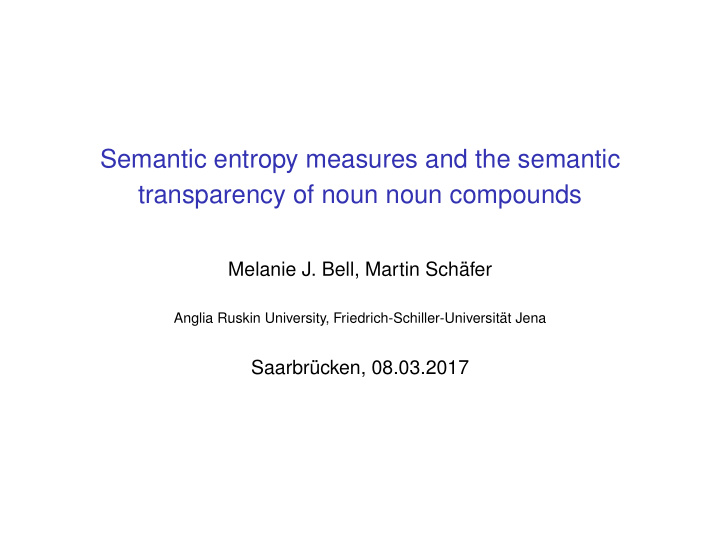



Semantic entropy measures and the semantic transparency of noun noun compounds Melanie J. Bell, Martin Sch¨ afer Anglia Ruskin University, Friedrich-Schiller-Universit¨ at Jena Saarbr¨ ucken, 08.03.2017
Why look at semantic transparency? ◮ Semantic transparency plays important role in storage and processing of compound words (e.g. Libben et al. 2003) ◮ BUT: Semantic transparency itself is still poorly understood! ◮ Our questions: Can semantic transparency be analysed in terms of semantic entropy measures? What happens if, in addition to entropy measures for semantic relations, entropy measures for word senses are considered?
Semantic aspects of interest ◮ The semantic relation between a compound’s constituents ◮ The senses of the constituents Consider the N1 constituent family of bank account : (1) relation example a. bank account IN b. bank charge FROM c. bank manager FOR d. . . . . . . (2) sense example a. bank 1 bank barn b. bank 2 bank clerk c. bank 3 bank switch d. . . . . . .
Previous studies ◮ Pham & Baayen (2013): entropy of semantic relations in the modifier family, relative to the lexicon as a whole, is negatively correlated with semantic transparency ◮ Schmidtke et al. (2015): relational entropy for individual compounds, based on the range of relations assigned to them by raters, is positively correlated with reaction time in lexical decision ◮ Bell & Sch¨ afer (2016): N1 relation proportion correlates positively with semantic transparency, N2 synset proportion negatively
Which semantic entropy measures? ◮ Relation entropy: given a compound, how are the probabilities for specific semantic relations distributed over the constituent families ◮ Synset entropy: given a compound, how are the probabilities for specific readings of its constituents distributed over the corresponding constituent families
Our transparency ratings: the Reddy et al. data ◮ 90 compounds from the ukWaC corpus ◮ Transparency ratings for the whole compound, the modifier and the head collected using Amazon Turk ◮ 30 ratings for each task for each compound ◮ 2415 tokens for the whole compound
Calculating the semantic entropy measures 1. Used the annotated compound family database from Bell & Sch¨ afer (2016) ◮ Took all strings of exactly 2 nouns that follow an article in the BNC ◮ Extracted constituent families for our compounds ◮ Added unspaced binominal compounds from CELEX ◮ Selected only those items which occur at least 5 times in the USENET corpus (Shaoul & Westbury 2010) ◮ Yielding 4553 types in the N1 positional families and 9226 types in the N2 positional families ◮ Coded these types for the semantic relation (after Levi 1978), and for the WordNet senses of the constituents (Princeton 2010) 2. Calculated N1 and N2 synset and relation entropies using the distribution in the corresponding families
Predictors ◮ Logarithmetised constituent frequencies ◮ Compound spelling ratio (Bell & Plag 2012) spelling ratio = ( unspaced frequency + hyphenated frequency ) (3) spaced frequency ◮ N1 synset entropy, N2 synset entropy ◮ N1 relation entropy, N2 relation entropy H = − ∑ n (4) i = 1 p i log p i ◮ All predictors were centered
Final model for compound transparency Random effects: Groups Name Variance Std.Dev. Corr rater (Intercept) 0.151629 0.38940 spellingRatioCentred 0.004015 0.06336 0.91 item (Intercept) 1.277178 1.13012 residual 0.930239 0.96449 Number of obs: 2307, groups: rater, 119; item, 81 Fixed effects: Pr( > | z | ) Estimate S.E. df t (Intercept) 2.96069 0.15224 88.64 19.448 < 2e-16 spelling ratio -0.25302 0.06904 76.69 -3.665 0.000454 N1 frequency 0.48070 0.07571 74.97 6.349 1.5e-08 N2 synset entropy 0.34824 0.18259 74.97 1.907 0.060317 N2 relation entropy -0.15070 0.24023 75.01 -0.627 0.532353 -0.57240 0.28352 74.99 -2.019 0.047070 interaction synset/relation entropy
The effect of spelling ratio Effect of spelling ratio 5 4 compound transparency 3 2 1 0 −4 −2 0 2 4 spelling ratio
The effect of N1 frequency Effect of N1 frequency 5 4 compound transparency 3 2 1 0 −3 −2 −1 0 1 2 3 frequency N1
The Interaction N2 synset entropy and N2 relation entropy Interaction N2 synset entropy and N2 relation entropy synsetEntropyInN2FamCentred 0 1 2 3 8 7 6 5 compound transparency 4 3 2 1 0 −1.5 −1.0 −0.5 0.0 0.5 1.0 N2 relation entropy
Interpreting the effects: the main effects ◮ The two main effects of spelling ratio and N1 frequency mirror the effects found in Bell & Sch¨ afer 2016 ◮ Positive correlation with N1 frequency: reflex of expectedness ◮ Negative correlation with spelling ratio: operationalising lexicalisation, reflex of non-compositional interpretations
Interpreting the effects: the interaction Relation entropy not negatively correlated with semantic transparency across the board ◮ Low N2 synset entropy: N2 relational entropy does not make much of a difference ◮ High N2 synset entropy: N2 relation entropy correlates negatively with compound transparency (mirroring Pham & Baayen’s 2013 finding for modifier families) ◮ The most transparent compounds have high synset entropy but low relation entropy
Conclusions ◮ First evidence that the interaction of entropy measures based on the head families plays a role for perceived transparency ◮ Overall further evidence for differentiated roles of modifier and head in compound processing ◮ Target compounds are all high frequent compounds, exploration of these measures on less frequent compounds is a task yet to be done.
Thank you!
Recommend
More recommend